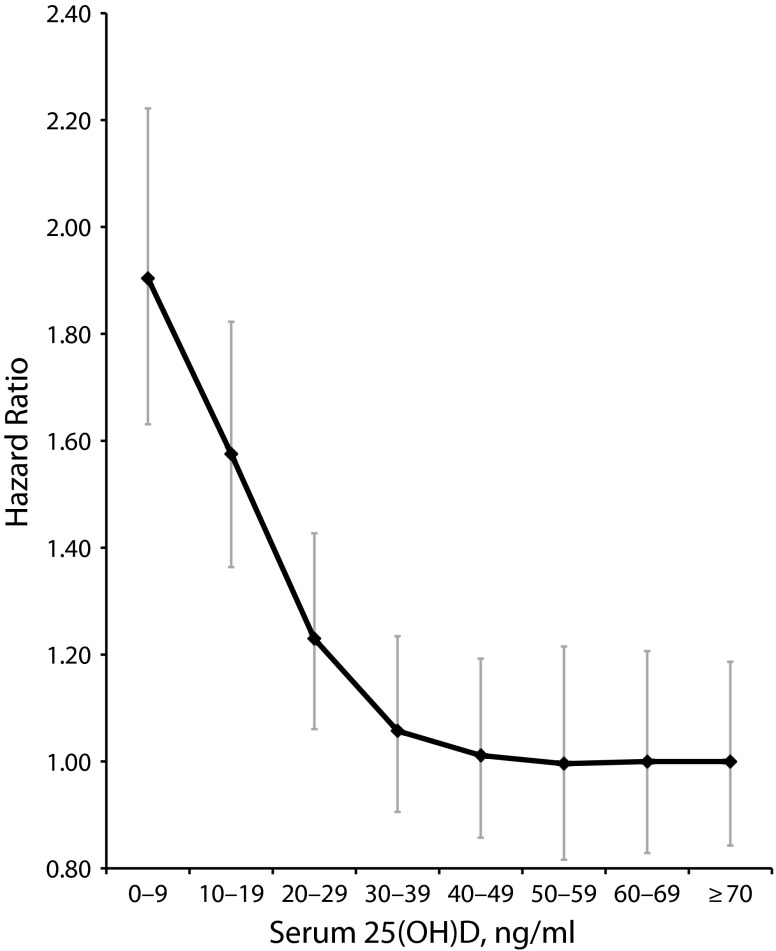What did they do?
This study is a meta-analysis, which means it is a study of other studies - they combine and analyze data from several previously conducted studies. In this case, the authors standardized individual participant vitamin D levels from eight independent studies for their analysis on vitamin D and mortality.
The data came from 26,916 European individuals with a median age of 61.6 years, 58% females, and a median 25(OH)D of 53.8 nmol/L (about 20 ng/ml).
How did they measure the results?
Study subjects were grouped into different ranges of baseline 25(OH)D measurement and death rates were compared between those ranges. The groupings were
|
Severely deficient
|
< 30 nmol/L
|
< 12 ng/ml
|
|
Inadequate
|
30-39.99 nmol/L
|
12-16 ng/ml
|
|
Inadequate
|
40-49.99 nmol/L
|
16-20 ng/ml
|
|
Sufficient
|
50 - 74.99 nmol/L
|
20-30 ng/ml
|
|
Sufficient
|
75 - 99.99 nmol/L
|
30-40 ng/ml
|
|
Sufficient
|
100 - 125 nmol/L
|
40-50 ng/ml
|
|
High concentrations
|
> 125 nmol/L
|
> 50 ng/ml
|
The biggest difference in mortality was seen in the comparison between the lowest category (< 12 ng/ml) and those in the middle sufficient category (30-40 ng/ml). Those in the lowest category were 1.67 times more likely to die than those in the higher category.
No J-shaped curve
This study created the top 2 sufficient groups (30-40 ng/ml and 40-50 ng/ml) because in the past they were the regions that would sometimes show decreased benefit - the area where the graph would take an uptick - the back half of the U or J-shaped curve.
The study population had most people < 30 ng/ml (22940, 85%). The largest group > 30 ng/ml was the first one - 30-40 ng/ml with 3125 people. The next two groupings had 679 and 172 people respectively. (Table 2 in paper). The risk for all-cause mortality was not significantly different in any of the groups above 20 ng/ml (50 nmol/L) - no J-shaped curve!
Figure 1 from paper
Cardiovascular Death
Cardiovascular death was also considered in these same groupings (the two highest were combined). Those with the lowest vitamin D levels, < 12 ng/ml, were 3.18 times more likely to die of cardiovascular related causes than those in the reference range of 30-40 ng/ml. As shown in table 3 of the paper, there was a continued decrease in cardiovascular death as vitamin D levels increased.
Cancer
The authors did not find a linear relationship between vitamin D and cancer - the cancer rate did not consistently go down as vitamin D levels increased, but, as shown in table 4 of the paper, all groups lower than the reference group of 30-40 ng/ml had a higher risk, and those in the highest group, >40 ng/ml, had a lower risk. Again, no sign of a J-shaped curve.
This data is consistent with previous research from Dr. Cedric Garland who has long noted that women need to get over 50 ng/ml to maximize the protective benefits against breast cancer. Again, it is always good to look at the data and read the paper - so see the specifics.
















